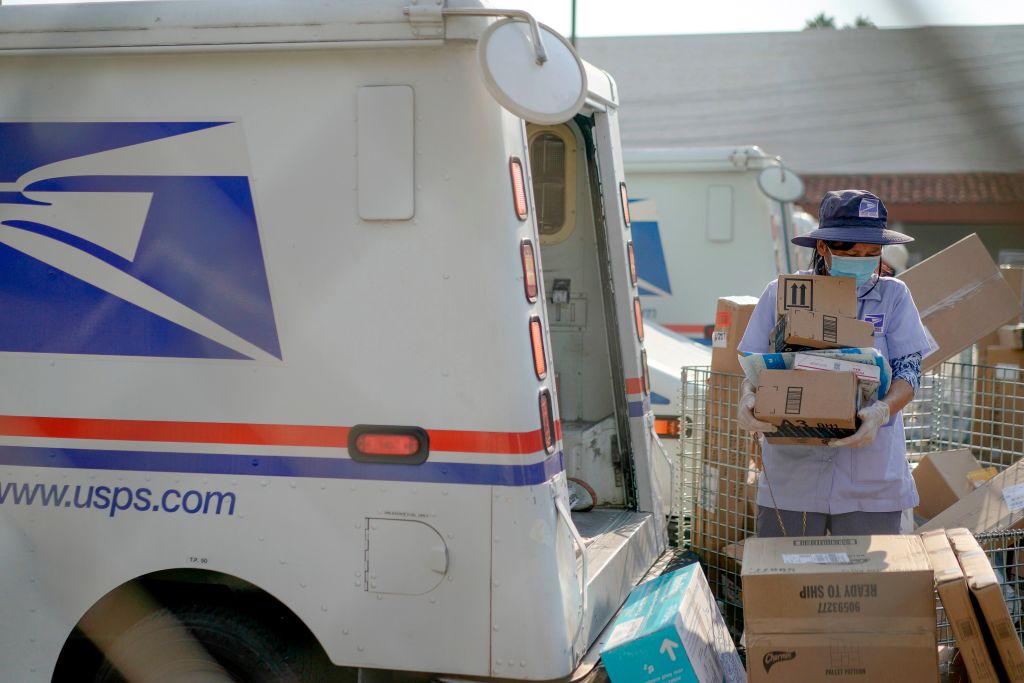Seattle
My local post office in suburban Seattle seems to be rigged to obstruct customers these days. After standing motionless for half an hour awaiting my turn, I find that I’ve lost the will to live even before the inevitable altercation with the masked clerk squinting back at me through a sheet of plastic. When you ask for the slightest bit of ‘consumer assistance’ — as their cheerful mission statement on the wall promises they’re only too happy to provide — they seem to get ferociously cross. Not long ago I was read the Riot Act by a young USPS employee because I politely asked if I might be allowed an inch or two of Scotch tape from one of the dozen or so open rolls of it I could see on the shelf behind her. She lectured me, at some length, on the policy of her ‘facility’ not providing such ‘resources’ free of charge, although, to be fair, she did go on to offer to sell me a 12-yard roll of the stuff for only $5.29, and also to draw my attention to the value pack of 16 rolls, with dispenser, retailing for the bargain price of $49.99.
Even this soul-destroying experience pales in comparison to current conditions elsewhere in our national postal system. Customers have seen ever-increasing delays in the delivery of essentials such as prescription drugs and government stimulus checks since the USPS started to dismantle 670, or 10 percent, of the network’s massive mail-sorting machines in a bid to staunch the service’s continuing financial hemorrhage. One postal worker at the regional facility in South Los Angeles reported this week that workers there had fallen so far behind in their manual sorting of the mail that gnats and rodents were swarming over packages of rotting meat, while a consignment of baby chicks had suffocated in their boxes.
Just further evidence of the sorry decline and fall of a once-proud American institution? Or proof that sinister forces are secretly engaged in a series of elaborate plots to subvert virtually every aspect of our daily lives? Earlier this month, nearly 200 House Democrats signed a letter accusing Postmaster General Louis DeJoy of acting to ‘accelerate the crisis’ at the USPS, specifically with regard to the surge of mail-in ballots expected in November. On August 22, Speaker Nancy Pelosi channeled her now seemingly permanent state of simulated moral outrage into convening a rare Saturday session of the House in order to approve a bill forbidding the USPS from making ‘any change’ that would limit service until after the election. Somehow the Speaker seems to have been not quite so exercised by matters such as the further unemployment-relief bill, which remains in a legislatively-induced coma while our lawmakers enjoy their protracted summer recess.
Perhaps Pelosi has been too busy of late with other matters, such as pressing Joe Biden not to debate Donald Trump because of the latter’s failure to ‘comport himself’ in a way she deems sufficiently presidential (shouldn’t we be the judge of that?) to notice the USPS’s continuing litany of financial losses. According to a May report by the Government Accountability Office, the postal service has been consistently bleeding money since 2006. Overall mail volume peaked that year at 213 billion pieces. That figure has since fallen by 33 percent, with stamped first-class mail — the primary means by which Americans used to stay in touch with one another — down a whopping 44 percent in 2019. The once pleasurable daily routine of opening the family mailbox has become a depressing ritual of sorting and rapidly discarding a deluge of grocery coupons and real estate fliers. Over the same timeframe, the number of delivery points served by the USPS has risen nearly 10 percent, from 147 million to 160 million. It’s an obviously unsustainable business model. The post office posted a $5.6 billion loss in 2016, a relatively modest $2.7 billion loss in 2017, a $3.79 billion loss in 2018, and a further $8.8 billion loss in 2019. Earlier this month, it announced that it had added another $2.2 billion in red ink in just the previous quarter.
[special_offer]
The USPS’s financial problems are only partly market-driven, however. The biggest drag on the system’s costs doesn’t come from any of the classic big-government staples of gross inefficiency or misuse of public money. (Under a business plan put in place under the Nixon administration in 1971, the post office receives no tax dollars for its operating expenses — no, there’s no misprint — and relies on the sale of its goods and services to fund itself.) Instead, they’re the direct result of a 2006 congressional mandate that requires the USPS to prepay an annual $6 billion into a fund that covers healthcare and other costs for future retired employees — not only post office employees, but those from other branches of the federal government as well. In addition, the USPS is obliged to dole out upward of $1.5 billion every year to the Department of Labor for workers’ compensation. Take that total $7.5 billion out of the equation, and the service would actually be perilously close to breaking even. ‘There’s no other entity on earth that operates like that. When I talk about it, people say it’s utterly absurd,’ says Oregon’s Democratic Rep. Peter DeFazio, the author of legislation that would significantly reform the USPS’s business model. No vote on DeFazio’s initiative has been scheduled.
Meanwhile, for all its problems, the much-maligned USPS actually does a highly creditable job in its primary role of delivering mail from point A to point B. Like most industries associated with paper and the written word, it may be that it permanently lingers in the economic doldrums, but its performance far eclipses that of similar operations around the world. In much of Western Europe, the national postal service has all but ground to a halt. In Britain, the cost of a basic first-class stamp has just risen to 76 pence (roughly $1, or around double our rate). The Royal Mail has been busted auctioning off lost parcels. Ask the French or the Italians how they rate the chances nowadays of a letter successfully reaching its destination. You would need to carry a full tank of gas and a day’s supply of food with you merely to find a functioning post office in most Scandinavian countries. The Swedish service, Posten, remarks blandly that it has ‘minimized [its] participation in the national market’, which is akin to one of those old Kremlin health bulletins assuring everyone that the dead leader was ‘resting comfortably’.
By contrast, the independent research group Oxford Strategic Consulting ranked the USPS first in overall performance among the 20 wealthiest nations in the world in 2011. The group’s report found that the US Mail successfully delivered over five times more letters per full-time carrier than Germany’s privatized Deutsche Post, and concluded, ‘If you could live anywhere in the world, and were sending a present to someone this Christmas, you’d want to be in America, Japan, or Australia.’
Far from the post-apocalyptical nightmare portrayed in the media, the USPS is actually an American success story, despite the attempts to cripple it by politicians on both sides of the aisle.


















